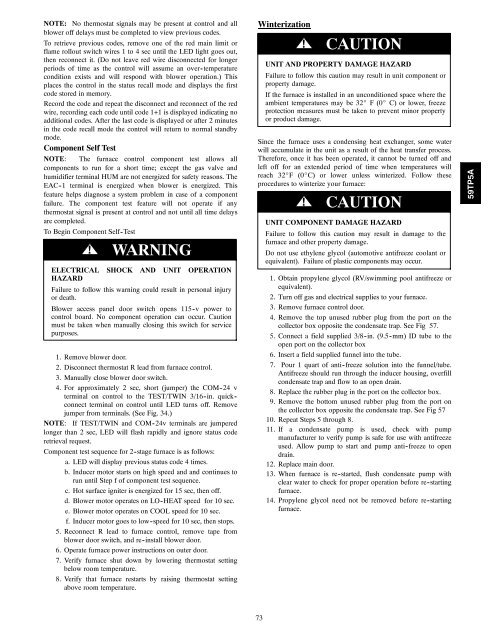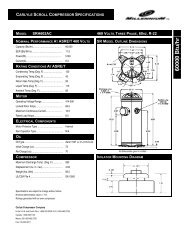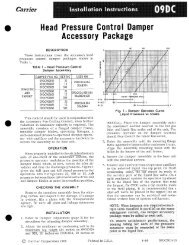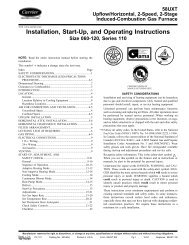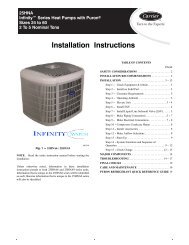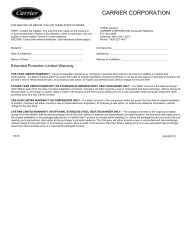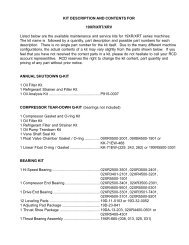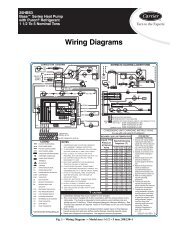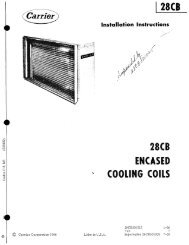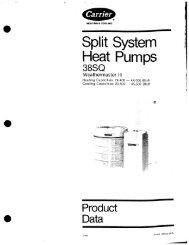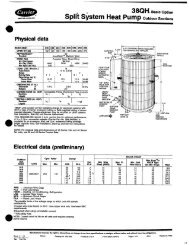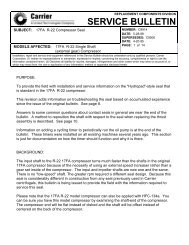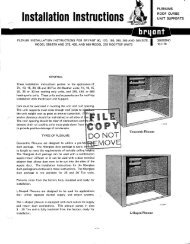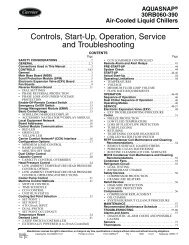59TP5ANOTE: If condensate has a heat pad attached to the trap, trace thewires for the pad back to the connection point and disconnect thewires for the heat pad.7. Remove the screw that secures the condensate trap to thecollector box, remove the trap and set aside.8. Remove the trap gasket from the collector box if it did not<strong>com</strong>e off when the trap was removed.9. Discard the old trap gasket.10. Rinse condensate trap in warm water until trap is clean.11. Flush condensate drain lines with warm water. Rememberto check and clean the relief port on the collector box.12. Shake trap dry.13. Clean port on collector box with a small wire.To re-install Condensate Drain and Trap:1. Remove adhesive backing from condensate trap gasket2. Install gasket on collector box3. Align the condensate trap with the drain opening on the collectorbox and secure the trap with the screw4. Attach the relief hose to the relief port on the condensatetrap and collector box.5. Secure tubing to prevent any sags or traps in the tubing.6. Connect condensate drain elbow or drain extension elbowto the condensate trap7. Connect the leads of the condensate heat pad (if used)8. Connect external drain piping to the condensate drain elbowor drain extension pipe.9. Turn gas on at electric switch on gas valve and at externalshut-off or meter10. Turn power on at external disconnect, fuse or circuit breaker.11. Run the furnace through two <strong>com</strong>plete heating cycles tocheck for proper operation12. Install control door when <strong>com</strong>plete.Checking Heat Pad Operation (If Applicable)In applications where the ambient temperature around the furnaceis 32_F or lower, freeze protection measures are required. If thisapplication is where heat tape has been applied, check to ensure itwill operate when low temperatures are present.NOTE: The Heat Pad, when used, should be wrapped around thecondensate drain trap. There is no need to use heat tape within thefurnace casing. Most heat tapes are temperature activated, and it isnot practical to verify the actual heating of the tape. Check thefollowing:1. Check for signs of physical damage to heat tape such asnicks, cuts, abrasions, gnawing by animals, etc.2. Check for discolored heat tape insulation. If any damage ordiscolored insulation is evident, replace heat tape.3. Check that heat tape power supply circuit is on.Cleaning Heat ExchangersThe following items must be performed by a qualified servicetechnician.Primary Heat ExchangersIf the heat exchangers get an accumulation of light dirt or dust onthe inside, they may be cleaned by the following procedure:NOTE: If the heat exchangers get a heavy accumulation of sootand carbon, both the primary and secondary heat exchangersshould be replaced rather than trying to clean them thoroughly dueto their intricate design. A build -up of soot and carbon indicatesthat a problem exists which needs to be corrected, such as improperadjustment of manifold pressure, insufficient or poor quality<strong>com</strong>bustion air, improper vent termination, incorrect size ordamaged manifold orifice(s), improper gas, or a restricted heatexchanger (primary or secondary). Action must be taken to correctthe problem.1. Turn off gas and electrical supplies to furnace.2. Remove control door.3. Disconnect wires or connectors to flame rollout switch, gasvalve, igniter, and flame sensor.4. Using backup wrench, disconnect gas supply pipe from furnacegas control valve.5. Remove two screws attaching top filler plate and rotate upwardsto gain access to screws attaching burner assembly tocell panel.6. Remove screws attaching burner assembly to cell panel.(See Fig. 61.)NOTE: Burner cover, manifold, gas valve, and burner assemblyshould be removed as one assembly.7. Clean heat exchanger openings with a vacuum and a softbrush. (See Fig. 58.)NOTE: After cleaning, inspect the heat exchangers to ensure theyare free of all foreign objects that may restrict flow of <strong>com</strong>bustionproducts.8. Reverse items 6 through 1 for reassembly.9. Refer to furnace wiring diagram and reconnect wires toflame rollout switch, gas valve, igniter, and flame sensor.10. Turn on gas and electrical supplies to furnace.11. Check furnace operation through 2 <strong>com</strong>plete heat operatingcycles. Look at burners. Burner flames should be clear blue,almost transparent. (See Fig. 59.)12. Check for gas leaks.72!WARNINGFIRE OR EXPLOSION HAZARDFailure to follow this <strong>warning</strong> could result in personalinjury, death, and/or property damage.Never purge a gas line into a <strong>com</strong>bustion chamber. Nevertest for gas leaks with an open flame. Use a <strong>com</strong>merciallyavailable soap solution made specifically for the detectionof leaks to check all connections. A fire or explosion mayresult causing property damage, personal injury or loss oflife.13. Replace main furnace door.Secondary Heat ExchangersThe condensing side (inside) of the secondary heat exchangerCANNOT be serviced or inspected without <strong>com</strong>plete removal ofthe heat exchanger assembly. Detailed information on heatexchanger removal can be obtained from your Distributor.Wiring DiagramsSee Fig. 63 for the Deluxe 4 -Way Multipoise Furnace wiringdiagrams.TroubleshootingUse the troubleshooting guide, the status code LED on the furnacecontrol and the <strong>com</strong>ponent test to isolate furnace operationproblems.A more detailed troubleshooting guide is available from yourdistributor.For an explanation of status codes, refer to service label located onthe furnace door (See Fig. 54.) The stored status codes will NOTbe erased from the control memory, if 115 -or 24 -v power isinterrupted. The control will store up to 7 status codes.NOTE: Removing blower door will open the blower door switchand terminates 115 -v power to the control.
NOTE: No thermostat signals may be present at control and allblower off delays must be <strong>com</strong>pleted to view previous codes.To retrieve previous codes, remove one of the red main limit orflame rollout switch wires 1 to 4 sec until the LED light goes out,then reconnect it. (Do not leave red wire disconnected for longerperiods of time as the control will assume an over-temperaturecondition exists and will respond with blower operation.) Thisplaces the control in the status recall mode and displays the firstcode stored in memory.Record the code and repeat the disconnect and reconnect of the redwire, recording each code until code 1+1 is displayed indicating noadditional codes. After the last code is displayed or after 2 minutesin the code recall mode the control will return to normal standbymode.Component Self TestNOTE: The furnace control <strong>com</strong>ponent test allows all<strong>com</strong>ponents to run for a short time; except the gas valve andhumidifier terminal HUM are not energized for safety reasons. TheEAC -1 terminal is energized when blower is energized. Thisfeature helps diagnose a system problem in case of a <strong>com</strong>ponentfailure. The <strong>com</strong>ponent test feature will not operate if anythermostat signal is present at control and not until all time delaysare <strong>com</strong>pleted.To Begin Component Self-Test!WARNINGELECTRICAL SHOCK AND UNIT OPERATIONHAZARDFailure to follow this <strong>warning</strong> could result in personal injuryor death.Blower access panel door switch opens 115 -v power tocontrol board. No <strong>com</strong>ponent operation can occur. Cautionmust be taken when manually closing this switch for servicepurposes.1. Remove blower door.2. Disconnect thermostat R lead from furnace control.3. Manually close blower door switch.4. For approximately 2 sec, short (jumper) the COM -24 vterminal on control to the TEST/TWIN 3/16 -in. quick -connect terminal on control until LED turns off. Removejumper from terminals. (See Fig. 34.)NOTE: If TEST/TWIN and COM -24v terminals are jumperedlonger than 2 sec, LED will flash rapidly and ignore status coderetrieval request.Component test sequence for 2 -stage furnace is as follows:a. LED will display previous status code 4 times.b. Inducer motor starts on high speed and and continues torun until Step f of <strong>com</strong>ponent test sequence.c. Hot surface igniter is energized for 15 sec, then off.d. Blower motor operates on LO -HEAT speed for 10 sec.e. Blower motor operates on COOL speed for 10 sec.f. Inducer motor goes to low -speed for 10 sec, then stops.5. Reconnect R lead to furnace control, remove tape fromblower door switch, and re-install blower door.6. Operate furnace power instructions on outer door.7. Verify furnace shut down by lowering thermostat settingbelow room temperature.8. Verify that furnace restarts by raising thermostat settingabove room temperature.Winterization!CAUTIONUNIT AND PROPERTY DAMAGE HAZARDFailure to follow this caution may result in unit <strong>com</strong>ponent orproperty damage.If the furnace is installed in an unconditioned space where theambient temperatures may be 32_ F(0_ C) or lower, freezeprotection measures must be taken to prevent minor propertyor product damage.Since the furnace uses a condensing heat exchanger, some waterwill accumulate in the unit as a result of the heat transfer process.Therefore, once it has been operated, it cannot be turned off andleft off for an extended period of time when temperatures willreach 32_F (0_C) or lower unless winterized. Follow theseprocedures to winterize your furnace:!CAUTIONUNIT COMPONENT DAMAGE HAZARDFailure to follow this caution may result in damage to thefurnace and other property damage.Do not use ethylene glycol (automotive antifreeze coolant orequivalent). Failure of plastic <strong>com</strong>ponents may occur.1. Obtain propylene glycol (RV/swimming pool antifreeze orequivalent).2. Turn off gas and electrical supplies to your furnace.3. Remove furnace control door.4. Remove the top unused rubber plug from the port on thecollector box opposite the condensate trap. See Fig 57.5. Connect a field supplied 3/8 -in. (9.5 -mm) ID tube to theopen port on the collector box6. Insert a field supplied funnel into the tube.7. Pour 1 quart of anti -freeze solution into the funnel/tube.Antifreeze should run through the inducer housing, overfillcondensate trap and flow to an open drain.8. Replace the rubber plug in the port on the collector box.9. Remove the bottom unused rubber plug from the port onthe collector box opposite the condensate trap. See Fig 5710. Repeat Steps 5 through 8.11. If a condensate pump is used, check with pumpmanufacturer to verify pump is safe for use with antifreezeused. Allow pump to start and pump anti -freeze to opendrain.12. Replace main door.13. When furnace is re-started, flush condensate pump withclear water to check for proper operation before re -startingfurnace.14. Propylene glycol need not be removed before re-startingfurnace.59TP5A73


